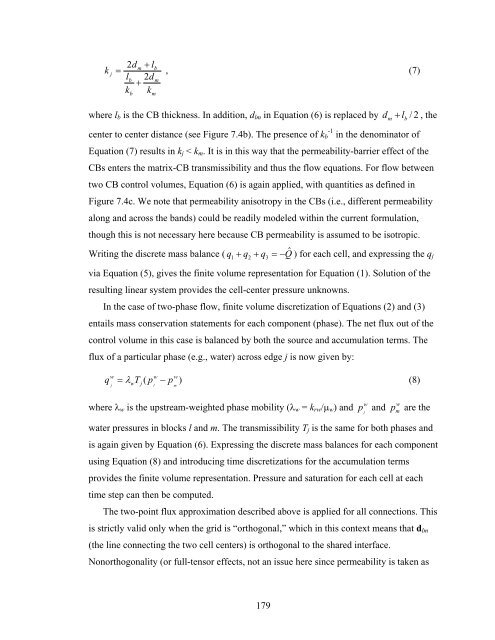structural geology, propagation mechanics and - Stanford School of ...
structural geology, propagation mechanics and - Stanford School of ...
structural geology, propagation mechanics and - Stanford School of ...
Create successful ePaper yourself
Turn your PDF publications into a flip-book with our unique Google optimized e-Paper software.
k<br />
2d<br />
m b<br />
j = , (7)<br />
lb<br />
2d<br />
m<br />
k<br />
b<br />
+<br />
+ l<br />
k<br />
m<br />
where lb is the CB thickness. In addition, dlm in Equation (6) is replaced by m b , the<br />
center to center distance (see Figure 7.4b). The presence <strong>of</strong> k<br />
d + l / 2<br />
b -1 in the denominator <strong>of</strong><br />
Equation (7) results in kj < km. It is in this way that the permeability-barrier effect <strong>of</strong> the<br />
CBs enters the matrix-CB transmissibility <strong>and</strong> thus the flow equations. For flow between<br />
two CB control volumes, Equation (6) is again applied, with quantities as defined in<br />
Figure 7.4c. We note that permeability anisotropy in the CBs (i.e., different permeability<br />
along <strong>and</strong> across the b<strong>and</strong>s) could be readily modeled within the current formulation,<br />
though this is not necessary here because CB permeability is assumed to be isotropic.<br />
Writing the discrete mass balance ( q + q + q = −Qˆ<br />
) for each cell, <strong>and</strong> expressing the qj<br />
1<br />
2<br />
via Equation (5), gives the finite volume representation for Equation (1). Solution <strong>of</strong> the<br />
resulting linear system provides the cell-center pressure unknowns.<br />
In the case <strong>of</strong> two-phase flow, finite volume discretization <strong>of</strong> Equations (2) <strong>and</strong> (3)<br />
entails mass conservation statements for each component (phase). The net flux out <strong>of</strong> the<br />
control volume in this case is balanced by both the source <strong>and</strong> accumulation terms. The<br />
flux <strong>of</strong> a particular phase (e.g., water) across edge j is now given by:<br />
w<br />
w w<br />
q = λ T ( p − p )<br />
(8)<br />
j<br />
w<br />
j<br />
l<br />
m<br />
w<br />
w<br />
where λw is the upstream-weighted phase mobility (λw = krw/µw) <strong>and</strong> p <strong>and</strong> p are the<br />
water pressures in blocks l <strong>and</strong> m. The transmissibility Tj<br />
is the same for both phases <strong>and</strong><br />
is again given by Equation (6). Expressing the discrete mass balances for each component<br />
using Equation (8) <strong>and</strong> introducing time discretizations for the accumulation terms<br />
provides the finite volume representation. Pressure <strong>and</strong> saturation for each cell at each<br />
time step can then be computed.<br />
3<br />
The two-point flux approximation described above is applied for all connections. This<br />
is strictly valid only when the grid is “orthogonal,” which in this context means that dlm<br />
(the line connecting the two cell centers) is orthogonal to the shared interface.<br />
Nonorthogonality (or full-tensor effects, not an issue here since permeability is taken as<br />
179<br />
l<br />
m
















